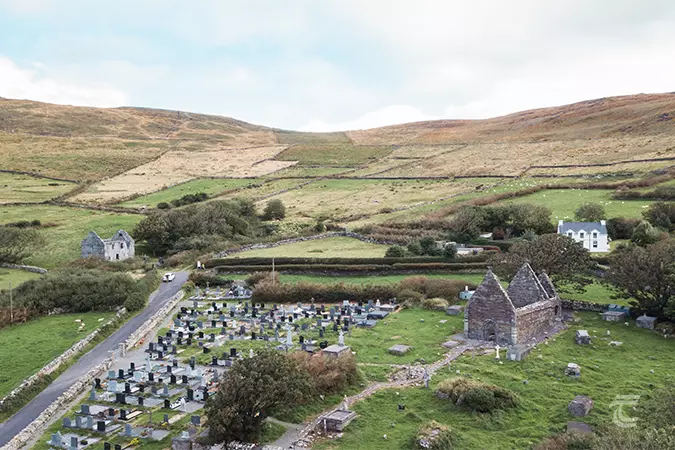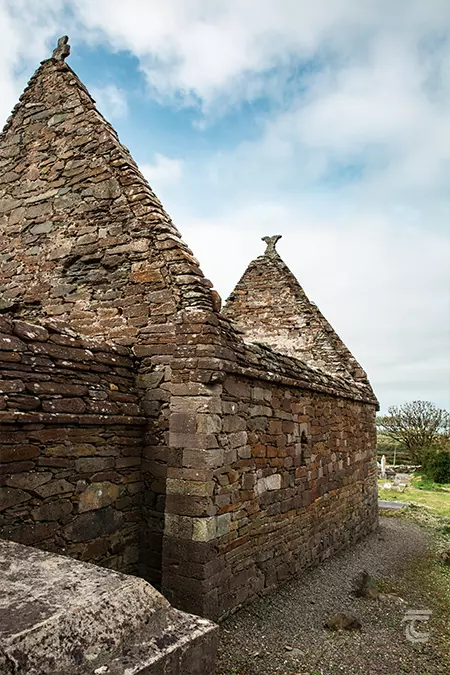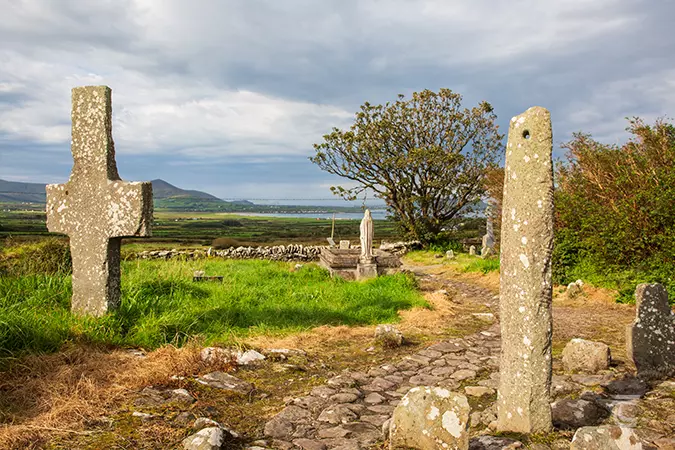Kilmalkedar Church
Kilmalkedar is one of Ireland’s most significant ecclesiastical complexes, and it is beautifully situated overlooking Smerwick Harbour. Kilmalkedar takes its name from Chill Maolchéadair, in honour of its founder, the little known St Maolcethair, who died in AD 636, though the site is more commonly associated with St Brendan the Navigator. The complex covers an area of over 10 acres and includes a Hiberno-Romanesque church, a large stone cross, an ogham stone, a sundial, St Brendan’s House and a number of important ecclesiastical features.
Few traces of Kilmalkedar’s ancient phases are still visible today, and no large monastic enclosure can be seen. Early evidence comes from the ogham stone, which may date to the 6th or 7th century (see below), and the large cross near it may also date from that era. Kilmalkedar’s significance grew when it played a central role in the celebration of St Brendan. The church is situated on the Cosán na Naomh (the Path of the Saints), an important pilgrimage route that leads to the summit of Mount Brandon. This significance led to Kilmalkedar controlling an extensive parish, including numerous important ecclesiastical landmarks in its hinterland, such as St. Brendan’s Oratory.
By the beginning of the 12th century, the great province of Munster was largely split into two competing power blocks. Des Mumha (South Munster) was ruled by the Mac Carthaigs and their allies (including the Corcu Duibne of the Dingle Peninsula). Tuad Mumha (North Munster) was ruled by the Uí Briain, who were allied to the Ciarraige, the dynasty who controlled much of Kerry including the influential ecclesiastical centre of Ardfert. The ascendancy went back and forth a number of times. It was in the context of this dynastic power struggle that the wonderful Romanesque church of Kilmalkedar was constructed.
The church is believed to have been the work of the same master architect that constructed Cormac’s Chapel on the Rock of Cashel for Cormac Mac Carthaig. He is thought to have sent the architect down to his Corcu Duibne allies. However, unlike his masterpiece on the Rock of Cashel with its continental influences, here at Kilmalkedar the mason perhaps had a slightly more conservative brief, to construct a church of stone that reflected and echoed the traditional Irish oak churches that were so familiar across the landscape at that time. The result is a beautiful building that reflects the European influences of the Romanesque, but still retains a distinctly Irish character. In this sense, Kilmalkedar can perhaps be said to be the first example of truly Hiberno-Romanesque architecture in Ireland.
Like Cormac’s Chapel, Kilmalkedar Church is also thought to be mid-12th century in date, though the chancel was extended in around 1200. Notable features of the church include the ornate doorway, which is typically Hiberno-Romanesque in design, with three orders decorated with zig-zag design and a carving of a human head in the centre, which perhaps represents the founder or an important church figure. The projecting antae and the blind arcading on the interior are also classic features of Romanesque architecture. The chancel arch is also finely decorated in the Romanesque style, and the ‘Alphabet Stone’ is positioned just next to the arch.
For practical information about visiting this site Click Here
Kilmalkedar is one of Ireland’s most significant ecclesiastical complexes, and it is beautifully situated overlooking Smerwick Harbour. Kilmalkedar takes its name from Chill Maolchéadair, in honour of its founder, the little known St Maolcethair, who died in AD 636, though the site is more commonly associated with St Brendan the Navigator. The complex covers an area of over 10 acres and includes a Hiberno-Romanesque church, a large stone cross, an ogham stone, a sundial, St Brendan’s House and a number of important ecclesiastical features.
Few traces of Kilmalkedar’s ancient phases are still visible today, and no large monastic enclosure can be seen. Early evidence comes from the ogham stone, which may date to the 6th or 7th century (see below), and the large cross near it may also date from that era. Kilmalkedar’s significance grew when it played a central role in the celebration of St Brendan. The church is situated on the Cosán na Naomh (the Path of the Saints), an important pilgrimage route that leads to the summit of Mount Brandon. This significance led to Kilmalkedar controlling an extensive parish, including numerous important ecclesiastical landmarks in its hinterland, such as St. Brendan’s Oratory.
By the beginning of the 12th century, the great province of Munster was largely split into two competing power blocks. Des Mumha (South Munster) was ruled by the Mac Carthaigs and their allies (including the Corcu Duibne of the Dingle Peninsula). Tuad Mumha (North Munster) was ruled by the Uí Briain, who were allied to the Ciarraige, the dynasty who controlled much of Kerry including the influential ecclesiastical centre of Ardfert. The ascendancy went back and forth a number of times. It was in the context of this dynastic power struggle that the wonderful Romanesque church of Kilmalkedar was constructed.
The church is believed to have been the work of the same master architect that constructed Cormac’s Chapel on the Rock of Cashel for Cormac Mac Carthaig. He is thought to have sent the architect down to his Corcu Duibne allies. However, unlike his masterpiece on the Rock of Cashel with its continental influences, here at Kilmalkedar the mason perhaps had a slightly more conservative brief, to construct a church of stone that reflected and echoed the traditional Irish oak churches that were so familiar across the landscape at that time. The result is a beautiful building that reflects the European influences of the Romanesque, but still retains a distinctly Irish character. In this sense, Kilmalkedar can perhaps be said to be the first example of truly Hiberno-Romanesque architecture in Ireland.
Like Cormac’s Chapel, Kilmalkedar Church is also thought to be mid-12th century in date, though the chancel was extended in around 1200. Notable features of the church include the ornate doorway, which is typically Hiberno-Romanesque in design, with three orders decorated with zig-zag design and a carving of a human head in the centre, which perhaps represents the founder or an important church figure. The projecting antae and the blind arcading on the interior are also classic features of Romanesque architecture. The chancel arch is also finely decorated in the Romanesque style, and the ‘Alphabet Stone’ is positioned just next to the arch.
For practical information about visiting this site Click Here
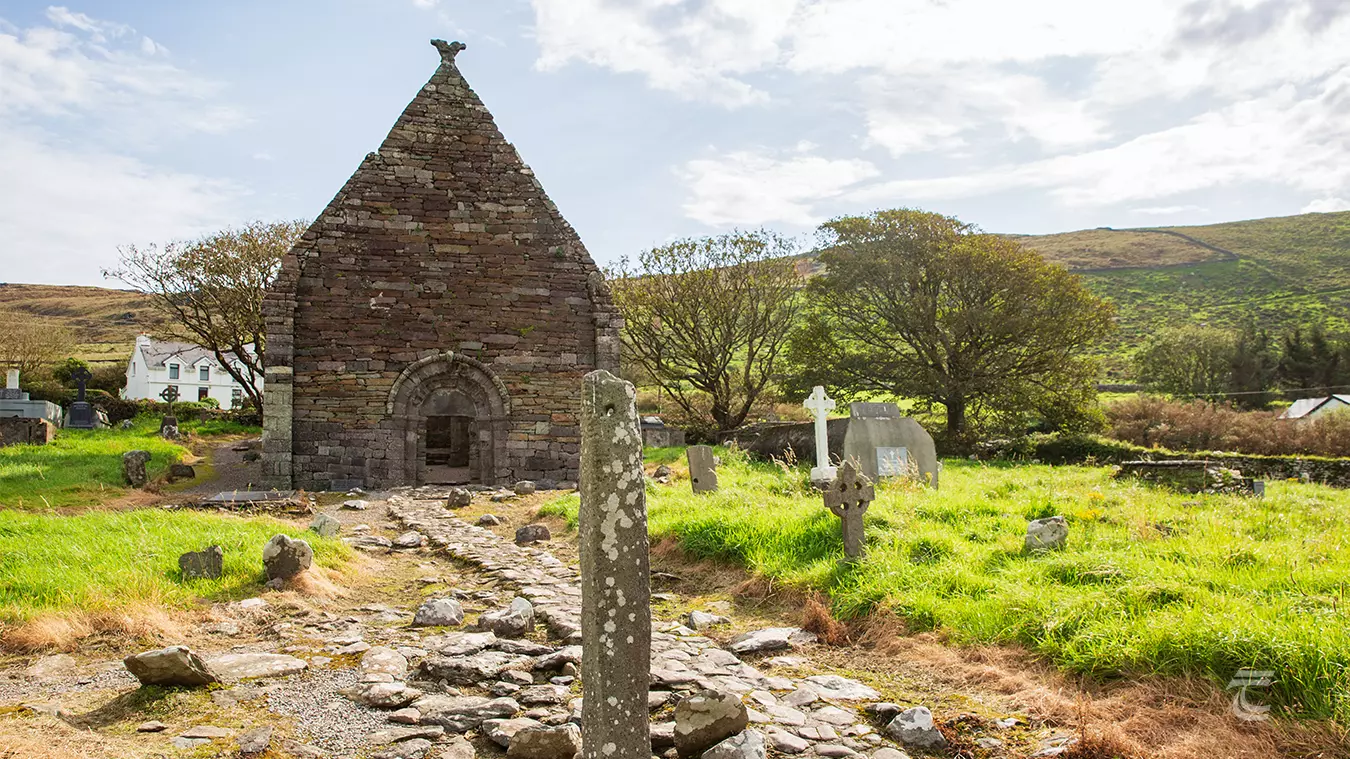
An ogham stone the stands along the pathway leading to Kilmalkedar Church • Kerry
Key Features of Kilmalkedar
The church at Kilmalkedar is especially notable for its Romanesque-style decorations. Originating on the continent, this style of architecture became popular in Irish churches during the 12th century. Typical features of Romanesque architecture in Ireland include rounded arches, elaborate decoration with zig-zags and chevrons, and stylistic depictions of foliage, animals or human heads.
Kilmalkedar Ogham Stones
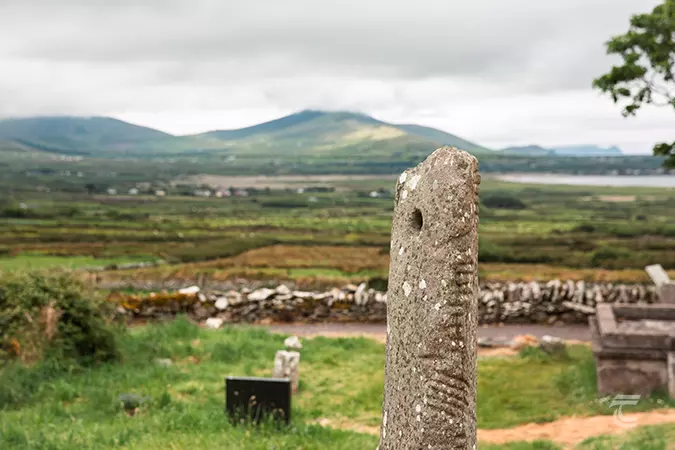
Kilmalkedar Ogham Stone • Kerry
In the graveyard you can see a holed ogham stone that is inscribed ANM MAILE INBIR MACI BROCANN (which has been translated to ‘the soul of Mael-Inbir, son of Brocán’). The prefix of ‘Mael’ suggests the stone commemorated a cleric or religious figure. There are traces of an earlier inscription, with the ogham for the letters ANM visible on southern side of the stone. This ogham stone provides the earliest evidence of activity on the site, as it is likely to date to the late 6th or early 7th century.
Kilmalkedar Stone Cross
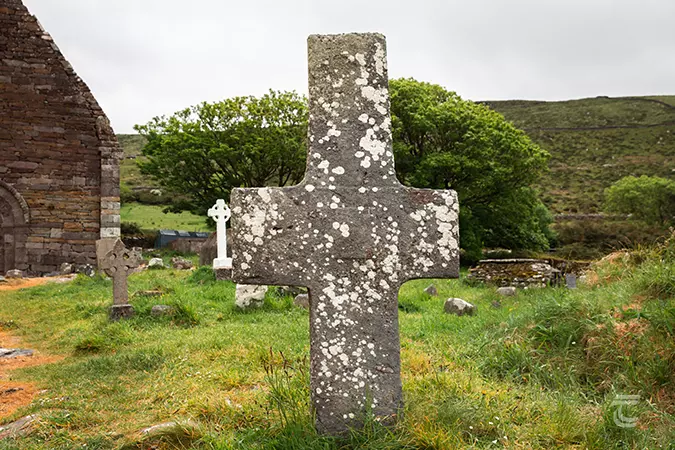
Kilmalkedar Stone Cross • Kerry
A large stone cross stands near to the ogham stone. It stands over 2m high, though when a nearby grave was being dug it was noted that the cross 1.8m of the cross shaft continued below the ground surface. The cross is rather plain and without decoration, beyond raised rectangular panels on the western face. Despite this, it is certainly a striking monument.

Kilmalkedar Stone Cross • Kerry
Kilmalkedar Sundial
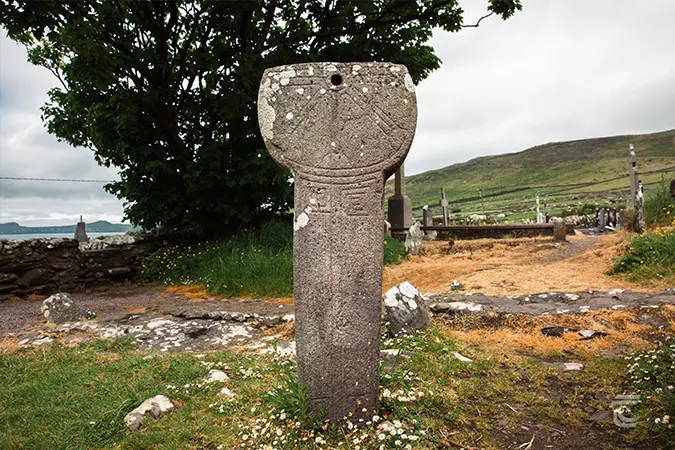
Kilmalkedar Sundial • Kerry
The sundial at Kilmalkedar is one of the best examples in Ireland. It stands at the western end of the graveyard, down the path from the ogham stone and cross. It has a flat rectangular shaft with incised line decoration, topped by a semi-circular head. The south-eastern face of the head is divided into four equal sectors that radiate out from a central hole. The hole once held a small projecting rod, possibly made of copper or wood, that cast a shadow into the sectors and thus marked the passage of the day. The reverse face is ornately decorated with a marigold cross motif.
The Alphabet Stone
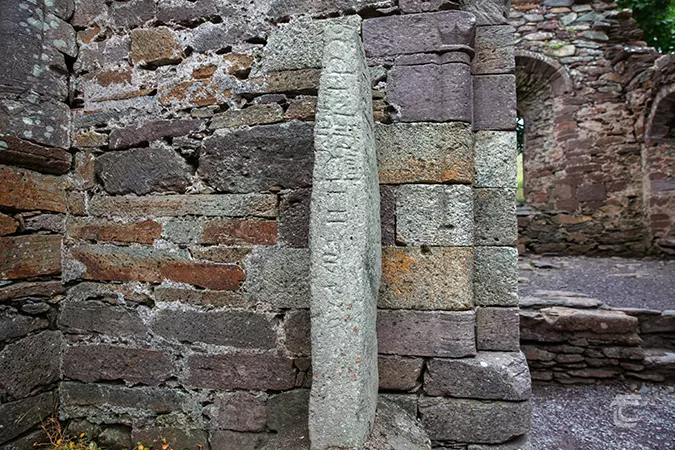
The Alphabet Stone • Kerry
The so-called Alphabet Stone is now located inside the church, next to the chancel arch. The pillar stone stands roughly 1.20m high, but it is broken at the top. The stone is named for the letters it bears, DNI, a contraction of ‘Domini’ (Latin for ‘Lord’), along with a Latin cross with scrolled terminals. This stone is thought to be possibly as early as 6h or 7th century in date.

The Alphabet Stone • Kerry
The Historic Graveyard
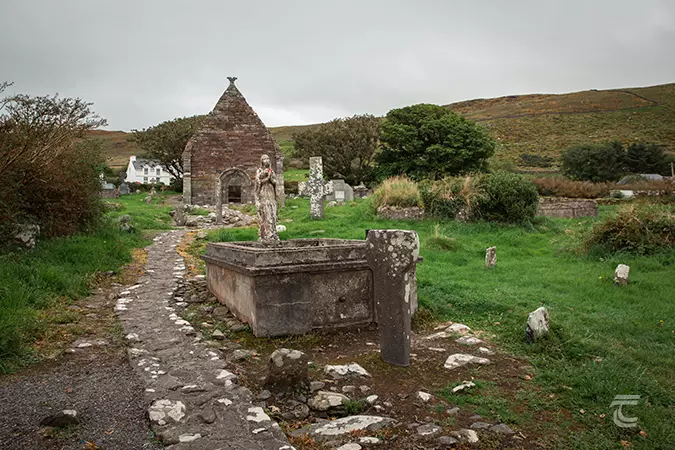
The Historic Graveyard • Kerry
The graveyard at Kilmalkedar has undoubtedly been in use since the first church was founded here in the 6th or 7th century. You can see a number of interesting historic graves from the 18th and 19th centuries, along with the occasional hint of earlier medieval graveslabs and crosses. Many of the older graves are marked by upright stones, some of which are notched or inscribed with a simple cross. The most interesting of these gravemarkers include two small Tau crosses, one of which is inscribed with a simple cross.
St Brendan’s House | The Priest’s House
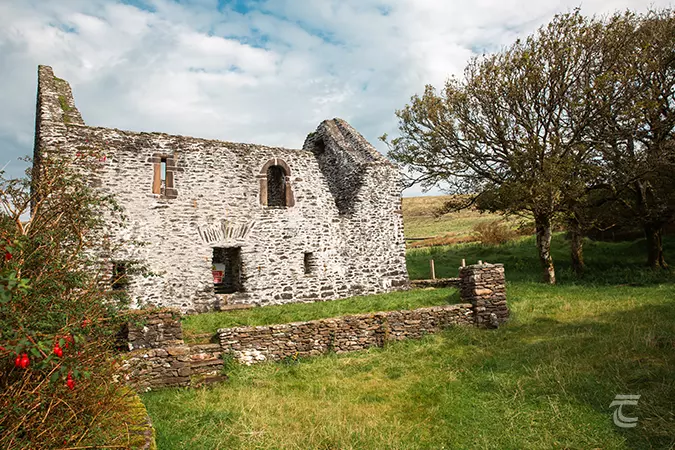
St Brendan’s House • Kerry
This building is thought to have provided accommodation for the priest during the later medieval period. It consists of a three storey rectangular building that is beautifully situated in a small enclosed area, fringed with fuchsia. A small holy well, known as St Brendan’s Well or Tobar Bréanainn, is situated near to the building, located just above the stream. A modern concrete wall has been constructed to enclose the well. On my last few visits, St Brendan’s House has had a locked gate with a large Keep Out sign on it, so I have only viewed it from beyond the gate.

St Brendan’s House • Kerry
Upper left: Kilmalkedar Church within a historic graveyard • Lower left: the stone cross & ogham stone • Right: the Romanesque church
Top: Kilmalkedar Church within a historic graveyard • Middle: the Romanesque church • Bottom: the stone cross & ogham stone
Explore more sites on the Wild Atlantic Way


